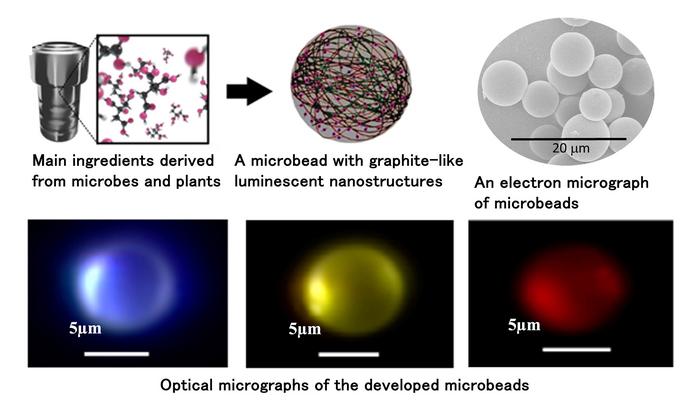1. A research team at NIMS has successfully developed an environmentally friendly, microspherical fluorescent material primarily made from citric acid. These microbeads emit various colors of light depending on the illuminating light and the size of the beads, which suggests a wide range of applications. Furthermore, the use of plant-derived materials allows for low-cost and energy-efficient synthesis.

Credit: Tadaaki Nagao
National Institute for Materials Science
1. A research team at NIMS has successfully developed an environmentally friendly, microspherical fluorescent material primarily made from citric acid. These microbeads emit various colors of light depending on the illuminating light and the size of the beads, which suggests a wide range of applications. Furthermore, the use of plant-derived materials allows for low-cost and energy-efficient synthesis.
2. Conventional luminescent devices commonly utilized thin films of compound semiconductors containing metals or sintered inorganic materials with rare earth elements. However, in a circular economy, there is a demand for fluorescent/luminescent materials that do not use rare earth elements, which have unstable supply chains, or metal elements with significant environmental impact. The microbeads we developed aim to provide low-environmental-impact fluorescent materials using abundant, easily obtainable plant-derived materials as the main ingredients.
3. The research team, led by the Nano-Photonics Group at the Research Center for Materials Nanoarchitectonics (MANA), developed microbead-type luminescent materials synthesized by heating citric acid and polyamino acids, which are used in soft drinks and food additives. These spheres utilize the fluorescence from soot- or graphite-like nanostructures within the heat-denatured, aggregated polyamino acids to emit red, blue, and yellow light, as well as near-infrared light invisible to the naked eye. By leveraging the light confinement effect of the microbeads, they have demonstrated that a single bead can emit various colors of light (different wavelengths of light).
4. In addition to emitting various colors of light, the fluorescence wavelength and light intensity distribution (fluorescence spectrum) of these microbeads vary significantly according to their shape and size. These unique fluorescence spectra for each bead can be used like authentication tags or barcodes. This capability allows for identifying individual beads using light, leading to applications such as color-changing paints, anti-counterfeit inks, and fluorescent probes that can identify and track individual beads in biological systems.
***
5. This research was conducted by a team consisting of Tadaaki Nagao, Group Leader of the Photonics Nano-Engineering Group at MANA, NIMS Postdoctoral Researcher Barun Kumar Barman (formerly a JSPS Postdoctoral Fellow), JSPS Research Fellow Hiroyuki Yamada, Researcher Keisuke Watanabe, Atsushi Goto, Group Leader of the Solid-State NMR Group at the Center for Basic Research on Materials, Principal Researcher Kenjiro Hashi, Principal Engineer Shinobu Ohki, and Engineer Kenzo Deguchi from the High Magnetic Field Characterization Unit of the Research Network and Facility Services Division at NIMS. This research was supported by a grant from the Japan Society for the Promotion of Science (JSPS).
6. The results of this research will be published in the June 13, 2024, online issue of the journal Advanced Science.
Journal
Advanced Science
Method of Research
Experimental study
Subject of Research
Not applicable
Article Title
Rare-Earth-Metal-Free Solid-State Fluorescent Carbonized-Polymer Microspheres for Unclonable Anti-Counterfeit Whispering-Gallery Emissions from Red to Near-Infrared Wavelengths
Article Publication Date
13-Jun-2024



